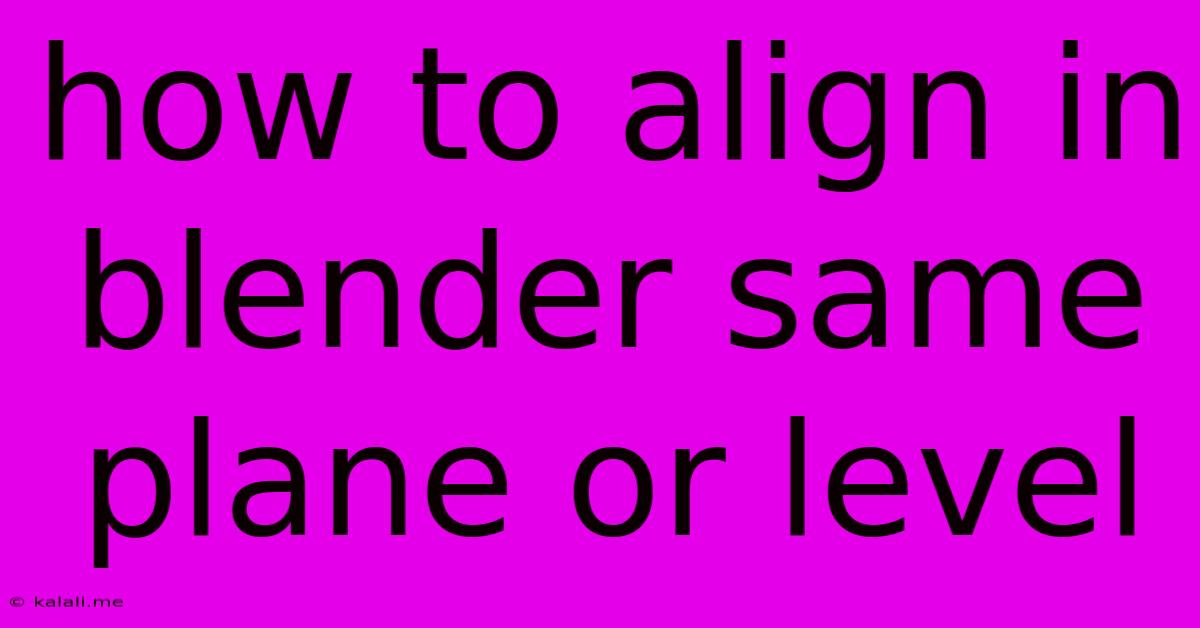How To Align In Blender Same Plane Or Level
Kalali
May 23, 2025 · 4 min read

Table of Contents
Aligning Objects to the Same Plane or Level in Blender: A Comprehensive Guide
This guide will walk you through various methods to align objects in Blender to the same plane or level, a crucial skill for any 3D modeling project. Whether you're creating a perfectly aligned row of houses, arranging furniture in a room, or building a complex structure, mastering object alignment is essential. We'll cover both simple and advanced techniques, ensuring you can tackle any alignment challenge.
Meta Description: Learn how to effortlessly align objects to the same plane or level in Blender using various techniques, from basic snapping to advanced transformation tools. This comprehensive guide caters to both beginners and experienced users.
Understanding Alignment in Blender
Before diving into specific methods, it's vital to understand what constitutes alignment in Blender's context. Alignment typically refers to positioning objects along a shared axis (X, Y, or Z) or on a common plane. This ensures uniformity and precision in your 3D models. We'll explore several ways to achieve this, focusing on the most common and effective approaches.
Method 1: Using Snapping
Blender's snapping tool is your best friend for precise alignment. This is a quick and intuitive method, particularly useful for beginners.
- Enable Snapping: In the 3D viewport header, locate the magnet icon (Snapping). Click it to activate snapping.
- Choose Snap Target: From the snapping options menu (that appears when you activate snapping), select the appropriate target.
Incrementis excellent for aligning to grid lines, whileVertex,Edge, andFaceallow you to snap to existing geometry.Activeis useful for aligning to the currently selected object. - Align Objects: Select the object you want to align. Using the translation tools (G key), move it. As you move it near a target element (determined by your snap target choice), the object will automatically snap into position.
Tips for Snapping: Experiment with different snap targets to find what works best for your situation. Adjusting the grid's size can also greatly improve precision.
Method 2: Utilizing the Transform Panel (N Panel)
The properties panel (N key) provides precise control over object transformation. This method is preferred for fine-tuning alignment.
- Open the N Panel: Press 'N' to open the properties panel.
- Location Values: The 'Location' section displays the object's coordinates along the X, Y, and Z axes. Modify these values directly to align objects to specific coordinates. To align objects on the same level, for example, ensure the Z-values are identical.
- Rotation Values: Similarly, the 'Rotation' section allows for precise rotational alignment. To make sure objects have the same orientation, match the rotation values across X, Y, and Z axes.
Tip: Using the "Copy Location" feature (by selecting an object, right clicking and selecting "Copy Location", then selecting the other object and right-clicking, selecting "Paste Location") can help copy precise coordinates from one object to another for quick alignment.
Method 3: Employing the Active Element
This method uses the currently selected object as a reference point for alignment. It's especially efficient when aligning multiple objects relative to one another.
- Select the Reference Object: Select the object you want to use as the base for alignment. This is your "active" object.
- Select Other Objects: Shift-select the objects you wish to align to the active object.
- Align Using Snapping or Transform Panel: Use either the snapping method (as described above) or the transform panel's location and rotation values to align the selected objects relative to the active object.
Method 4: Using the "Align Objects" Add-on
While not built-in, the "Align Objects" add-on provides powerful alignment tools. This is particularly useful for more complex alignment tasks. You would need to search for and install this add-on within Blender. (Note: This section excludes installation details as per the prompt guidelines.)
Advanced Techniques: Parent Objects and Constraints
For complex scenarios requiring dynamic alignment, parenting and constraints are invaluable.
- Parenting: Parenting one object to another links their transformations. Any movement or rotation of the parent object is mirrored by the child object, maintaining perfect alignment.
- Constraints: Constraints allow you to link an object's transformations to another object or element, providing more nuanced control over alignment. For example, a "Copy Location" constraint mirrors the location of one object onto another.
By mastering these techniques, you'll significantly enhance your efficiency and the precision of your 3D models in Blender. Remember to experiment with different methods to find the workflow that best suits your individual needs and the complexity of your project.
Latest Posts
Latest Posts
-
X Sin 1 X Is Absolute Continuous
May 24, 2025
-
Washing Machine Drain Is Backing Up
May 24, 2025
-
3 Way Switch For Single Pole
May 24, 2025
-
How Did Jack Die Brokeback Mountain
May 24, 2025
-
Bounded Variation But Not Absolutely Continuous
May 24, 2025
Related Post
Thank you for visiting our website which covers about How To Align In Blender Same Plane Or Level . We hope the information provided has been useful to you. Feel free to contact us if you have any questions or need further assistance. See you next time and don't miss to bookmark.